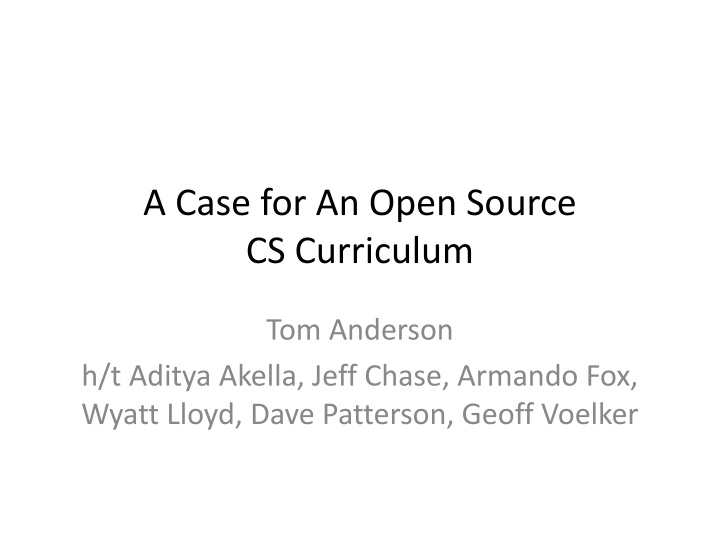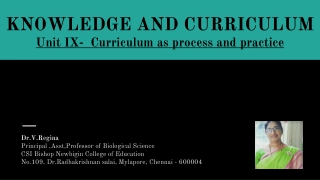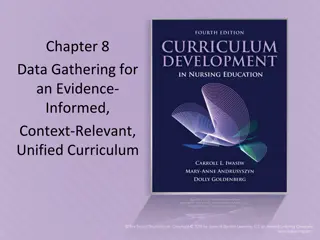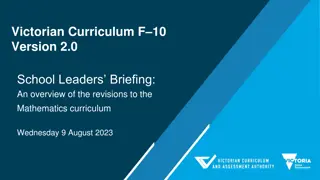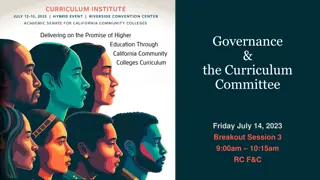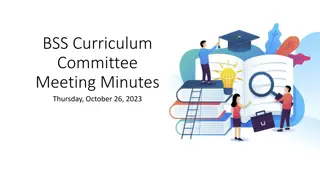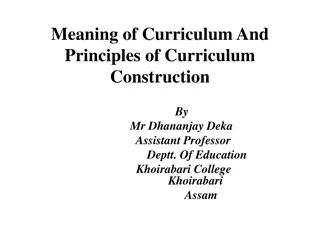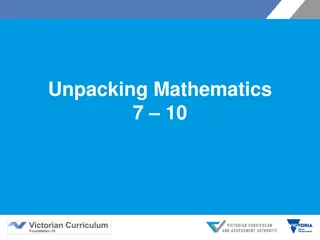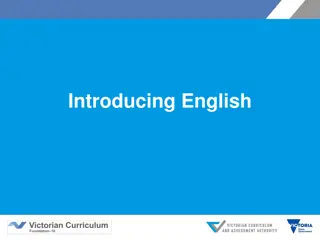Open Source Curriculum Insights
Dive into the necessity of an open source curriculum for computer science education, exploring workforce trends, supply and demand of CS graduates, economic opportunities, and challenges faced in traditional teaching methods.
Download Presentation

Please find below an Image/Link to download the presentation.
The content on the website is provided AS IS for your information and personal use only. It may not be sold, licensed, or shared on other websites without obtaining consent from the author.If you encounter any issues during the download, it is possible that the publisher has removed the file from their server.
You are allowed to download the files provided on this website for personal or commercial use, subject to the condition that they are used lawfully. All files are the property of their respective owners.
The content on the website is provided AS IS for your information and personal use only. It may not be sold, licensed, or shared on other websites without obtaining consent from the author.
E N D
Presentation Transcript
A Case for An Open Source CS Curriculum Tom Anderson h/t Aditya Akella, Jeff Chase, Armando Fox, Wyatt Lloyd, Dave Patterson, Geoff Voelker
Is There a Problem? Bound and Morales, Workforce Trends in Computer Science, 2016 US added an average of ~ 100K new jobs in CS per year since 1994
Do We Need That Many CS Grads? Supply or Demand? 60K CS bachelors degrees in 2015 in the US US added 100K new CS jobs/year (1994-2015) Steady state attrition requires 60K new hires/year Estimated 240K CS job openings in US Largely not a problem of student interest 15% of entering UW freshmen intend to major in CS Not surprising given the job market for non CS BAs
How Big an Opportunity? Impact of supply of tech degrees on metro GDP Peri et al., Journal of Labor Economics, 2015 1% increase in tech degrees in metro area 7% increase in avg income, for other BA holders 3% increase for non-college educated workers Similar to estimated benefit to DC of Amazon relo $15B per year by 2030 Plus benefit to students themselves New Berkeley CS grads 2x salaries of non-CS grads Nationwide? 1% of workforce is 1.5M 10 years at 150K degrees/year => $1T/year
The Heroic Professor? Writes papers Manages graduate students Stays up to date on recent research Understands how students learn best Determines best way to teach each topic Develops great custom-built course projects Writes textbooks to share educational knowledge Leaps tall buildings
The Reality Shortage of faculty for in-demand topics Typical OS teacher took an undergrad OS class CS teaching lags technology frontier, badly Almost no one has time for course development Assignments and projects aren t widely shared It is a lot of work! And you ll see even more online solution sets Even slides are often shared only on Piazza Except among friends, or by textbook authors Fewer textbooks are being written
Private Schools Arent Big Enough Graduating the most CS/CE BAs (US News top 50, first majors) Graduating the least CS/CE BAs (US News top 50, first majors) 1. MIT (31%) 2. Caltech (26%) 3. Stanford (16%) 4. CMU (12%) 5. Princeton (10%) 6. Columbia (10%) 18. Chicago (4.6%) 19. Yale (4.5%) 20. Hopkins (4.5%) 21. NYU (4.4%) 22. USC (4.2%) 23. Northwestern (3.7%) Private schools in top 50: 3600 total BA degrees (2017) Heroic professor model works for a few students.
Public Universities to the Rescue? Public colleges produce the large majority of BAs 65% of 4 year degrees in the US 73% of 4 year engineering and CS degrees Tier 1 research schools aren t enough Top 50 ranked schools in CS (public and private) produced about 15K CS/CE BAs in 2017 Still far short of workforce need Need solutions that work inexpensively, at scale, at non-tier 1 schools
Public Research Universities Increasing technical sophistication of economy Hire faculty who do both research and teaching Develop knowledge that pushes the economy forward Train the next generation of students in that knowledge An education open to all who can benefit from it a path to levelling income inequality (in theory)
The Paradox of Public Research Universities The public thinks we are being paid to teach Students are funding most of the cost of the flagship state universities We think of our job as research We spend most of our time doing research Most of us try to minimize the amount of time we spend teaching
Public Schools Graduating the most CS/CE BAs (top 30 publics, first majors) Graduating the least CS/CE BAs (top 30 publics, first majors) 1. Georgia Tech (16%) 2. UCSD (11%) 3. Michigan (8%) 4. UC Irvine (8%) 5. UIUC (7%) 6. Minnesota (6%) 25. Ohio State (3%) 26. Arizona (3%) 27. Washington (3%) 28. Utah (2.9%) 29. UC Santa Barbara (2.7%) 30. UCLA (2.6%) 15% of incoming UW want to major in CS. Most public schools are serving many fewer students than the underlying workforce need.
The CRA Consensus 1. Need more CS BAs 2. Fund CS PhD education via NSF 3. Wait 6 years 4. CS PhDs take faculty jobs 5. They produce more BA degrees 6. Wait 6 years 7. More CS PhDs take faculty jobs
Taulbee Survey Faculty at tier 1 research schools graduate an average of 0.3 PhDs/year Fairly consistent across public/private Also across different school rankings Only 30% of CS PhDs take academic jobs Faculty produce an average of 1 new assistant professor every decade or so Minus faculty leaving for industry
Is NSF the Bottleneck? NSF funding for CS research has increased 3.5x since 1994 $200M/year in 1994 -> $712M/year in 2017 Excluding NSF cyberinfrastructure Roughly in line with increase in CS jobs in broader economy 800K in 1994 -> 2.6M in 2015
Recap Massive underproduction of CS degrees relative to industry need Large missed opportunity for economic growth Tier 1 schools producing too few students Even large increases would only make a dent Need solutions that work for mid-tier colleges Typically not where research PhDs go to teach But it is where middle and low income students go to learn
Equality of Opportunity Project Innovative study of anonymized tax records Parent and child tax returns, zip codes Anonymized college student records US neighborhoods are segregated by income Move a poor child to a wealthy neighborhood Outcomes converge at rate of 4%/year Universities as segregated as neighborhoods Few low/middle income students attend tier 1s Those who do end up similar to wealthy kids
Top CS Research Universities US students from top 10% / bottom 60% Public Private UW Berkeley UCLA UCSD Michigan Texas GaTech 1.2 1.3 1.0 0.6 2.9 1.4 Stanford MIT Princeton CMU Cornell Caltech 2.8 1.8 4.2 2.6 2.5 4.5 1.8 Data for students born in 1991, includes (most) transfer students International students at public schools are likely even more skewed
Top CS Research Universities Median Family Income (US only) Public Private UW Berkeley UCLA UCSD Michigan Texas GaTech $113K $120K $105K $ 82K $154K $124K Stanford MIT Princeton CMU Cornell Caltech $168K $137K $186K $155K $152K $146K $130K Data for students born in 1991, includes (most) transfer students International students at public schools are likely even more skewed
Top Research Universities Pell Grants, all undergrads Pell grant threshold is roughly median income (due to ARRA) Public Private UCSD UCLA Berkeley Texas UIUC UW GaTech Michigan Wisconsin 34% 34% 28% 24% 21% 21% MIT Cornell Princeton Stanford Caltech CMU 17% 16% 16% 15% 12% 12% 15% 15% 13%
College Choices of Low Income Students (Hoxby and Avery 2013) 80% of highly qualified low income students are undermatched in school quality Top 4% of SAT scores, high GPA in high school That is, very strong students Most low-income students apply only to colleges within 50 miles of home Going away to college is often not an option Need to teach students where they live
A Few Examples University of Central Florida 38% Pell grant; 37% URM Graduated 480 CS+CE majors in 2017 (3.6%) Texas A&M Commerce 47% Pell; 43% URM Graduated 42 CS majors (2.5%) UMass Boston 40% Pell; 31% URM Graduated 37 CS majors (1.4%)
Fallacy of Elite Projection Belief that public services should be designed to be attractive to the elite World class airports, train stations, universities, Means fewer services get built Leaves most citizens behind Instead, we need solutions that are designed to work for everyone
Geographic Dispersion Software is eating the world Becoming an essential element of every major enterprise Ex: manufacturing, agriculture, health care management, elections Geographically dispersed economic benefits if we can create a dispersed knowledge base Not everyone will move to the valley
Types of Teaching Knowledge (h/t: CMU Eberly Center) How to teach in general Not my expertise! Subject knowledge Concentrated at tier 1 schools Which are highly income segregated How to teach subject (in context) Also concentrated at tier 1 s, but lessons may not apply to all audiences
Coursera/EdX? Successful model for students who are already self-guided learners Wherever they live around the globe What about everyone else? Need a human being to help problem solve Why are my students having difficulty with a concept? How can I explain it better to them? Not a curriculum Most of the effort at CS1/CS2 and specific skills, partly due to the economic model
Flipped Classrooms? Using someone else s videos at another institution? Undercuts the authority of the teacher Still need local problem solving and adaptation May work well for CS1 outreach to high schools Using someone else s textbook/assignments/autograding scripts at another institution? This often works really well Fewer bugs, clearer expectations,
Tailored Instruction Controlled experiment at Texas-Austin (Psych 1) Lecture vs. lecture + online quiz about previous lecture Quiz auto-tailored to the student s comprehension, based on previous answers Almost no effect on grades for high income students About a half a grade point difference in GPA for low income students => impact on other classes! In the skill set of every instructor Outside of the time budget of almost every instructor
SIGCSE Isn t there already a conference dedicated to educational issues? Almost exclusively attended by instructors Very little mixing with research faculty Lots of innovation for CS 1, CS 2 Many competing alternatives Not as much progress as you go higher into the curriculum Not for a lack of trying
What is to be done? Solutions that are effective at scale At schools without research programs With the faculty at those schools as allies Without spending a lot of money And you won t get rich or famous Increase number of CS students nationwide Improve quality of CS teaching nationwide Improve income diversity of CS graduates Improve ethnic diversity of CS graduates
What is to be done? How do we help ranked schools teach more students and more advanced material? Many already teaching very large classes Lots of time spent treading water How do we help mid-tier schools teach more students and more advanced material? Often teach multiple classes/term Lots of time spent treading water
We Have a Lot Already For some topics, textbook authors have already put together most of what we need Examples: CS:APP, others For some topics, projects in wide use Some even with autograding For other topics, there s work to do Especially true in systems, imo It s a large step from local use to global use What if we coordinated our efforts?
An Open Source CS Curriculum An entire undergraduate curriculum Roughly 20 courses Focus on course software, not lecture delivery Every school has teachers Need to enable them, not compete with them Need range of assignment difficulty Course in a box Problem sets, programming modules, documentation Automated grading, autotuning of difficulty Open source: design for change
Open Source: Linux Model Architect for extensibility Ex: adding a new file system, or a new packet queue scheduler, or a new device driver Allows large number of people to contribute Core architecture team defines APIs decides which community contributions are adopted into mainline source tree Anyone can fork and customize Ethic of adoption of community contributions
A Curriculum Hard to make course materials effective in isolation What have students already mastered? Need the set to hang together as a group An answer to: what do I need to do to learn CS? Requires coordination Enable others to contribute content Ex: MIT has a number of P/F skills courses offered by students for students Loosen idea that only faculty set standards
How Many Courses? At UW, 20 (quarter) courses taken by a majority of majors CS 1 CS 2 Web programming Discrete math Probabilistic reasoning Data structures Software design and testing Machine structures Systems programming Programming languages Database systems Algorithms Database implementation Operating systems Distributed systems Computer security Networks AI Machine learning Computer vision
Case Study: Distributed Systems Grew course from 42 to 175 in 3 years TA s entirely self-generated Build a dynamically sharded linearizable and highly available key-value store with multikey transactions Oddity distributed systems debugger Model checked, autograded assignments Students self-diagnose Lectures and labs online And solution sets
Community Colleges Can we extend this model to non-4 year degrees? Two year program in math, data science, and computing With employers at the other end Improve graduation rates Focus teachers on helping students Not on grading, assignment creation, Continuing ed is part of their charter Not just for young adults Berkeley is prototyping this of all community college students are in CA
What About Copying/Cheating? We re losing the battle Posting solutions, and using posted solutions, is endemic Students have an exit test: their job interview Enhanced by having a standard curriculum! Copying often triggered by lack of help and unclear expectations Reduce salience of project grades? Exams can test whether student mastered the material Centralize tools for copy detection Teachers don t have enough time to make this a priority
Cost Developing a 2-week assignment, hosted in the cloud with documentation and autograding A small integer number of person-months of effort Each course needs four or five of these, possibly building on top of each other Plus common software infrastructure About the cost of an NSF Expedition, in total across all subjects
Next Steps Community building White paper explaining the effort Workshop to organize a proposal Contact me if you are interested
Summary We have an opportunity for a large step improvement in computer science education on a national scale, by taking the effort we are already putting into course software, and organizing it a bit differently
